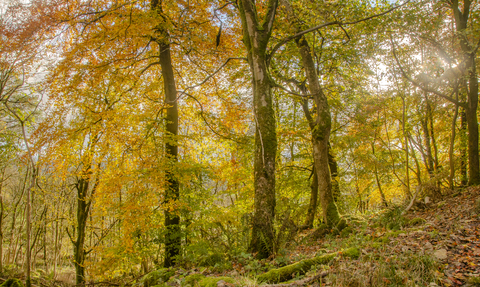
Garbutt Wood Nature Reserve
Location
Know before you go
Dogs
Only on public footpaths.
When to visit
Opening times
Open at all times. We recommend a half day trip for this reserve but if you want a longer outing why not combine with walks around Sutton Bank, where you might see turtle doves and nightjars in summer. Alternatively, check out the nearby Lake Gormire for wetland plants, including the rare tufted loosestrife!Best time to visit
March to September (April to May for bluebells)About the reserve
This spellbinding woodland is at its most magical when the flowers are out in May and June, and the songs of redstarts, blackcaps and other breeding birds create an enchanting atmosphere. Whitestone Cliff, towering above the woodland, adds a sense of drama, while on a smaller scale there are micro-habitats ideal for lichens, mosses and ferns. In the north-west corner of the site, you can find plants including common fleabane, ragged robin and common spotted orchid.
Contact us
Environmental designation
About
Interesting for both its biological and geological features, this impressive nature reserve with various habitats is home to good numbers of breeding birds, beautiful flowering plants, and oak and birch woodland.
From 305m above sea level on the cliff top, the nature reserve tumbles 150m to its western boundary just above Lake Gormire. The Whitestone Cliff itself has a sheer face of around 15-21m. The last major rock fall was in 1775, an event recorded in the diary of Methodist John Wesley who was preaching in the area.
Above the cliff you will find bilberry and heather moor, whereas below the boulder-strewn scree many micro-habitats have established ideal for lichens, mosses and ferns. Here you will also find evidence of man’s activity as the sandstone from the cliff was quarried until 1840 and shaped into square sleepers for use on the railways.
The main area of woodland is acidic consisting mainly of birch, oak and holly, but pockets of other tree species occur including aspen, ash, sweet chestnut and sycamore. The more open areas of the nature reserve are covered with bracken and scrub. In the north west corner of the site where springs have made it too wet for the bracken, remnants of the plants that once existed survive. Common fleabane, ragged robin and common spotted orchid are amongst the flowers that flourish.
Seasonal highlights
- Spring: Plants - Wood sorrel; Moschatel Birds - Tree pipit; Blackcap; Redstart
- Summer: Plants - Common spotted orchid; Common valerian; Meadow sweet; Invertebrates- Ringlet; Meadow brown
- Autumn: Fungi - Fly agaric; Milk cap
- Winter: Birds - Sparrow hawk; Bullfinch
History
The earliest reference to the woodland is from Tudor times.
Established as a nature reserve in 1966, the wood forms part of Gormire SSSI and is part of a network of woodland and forestry plantations that stretches for some distance along the Hambleton Hills.
Currently Yorkshire Wildlife Trust leases the land from the Forestry Commission; the Trust’s main management focus is the control of sycamore. Bracken is also controlled in some areas by pulling, bashing or tree planting.
Directions
Public transport
Buses from Thirsk stop at the Sutton Bank Visitor Centre
By car
Take the A170 Thirsk to Scarborough road. Climb the steep Sutton Bank and park in the visitor centre car park on the left shortly after reaching the top of the climb. There is a parking charge. From the car park, follow the Cleveland Way footpath north and then look for a footpath left off the track. This footpath is rocky and descends steeply down through the site to Lake Gormire.
Amazing woodland with Gormire Lake at the bottom and amazing views from the top.Google Reviews

The autumn colours were even more beautiful when the sun came out
Photo Credit - Telling our Story Volunteer, Sara


